Tale from the Field: Celebrating Black History, Rooted in Plants, at the New York Botanical Garden
Arvolyn Hill works at the New York Botanical Garden (NYBG) and attended a BEETLES Leadership Institute in August 2019. In the winter of 2020, Arvolyn designed and launched a program Celebrate Black History: Rooted in Plants, focused on the influence of the African diaspora on the plant world. We interviewed her to hear more about the program and design process of this in-person program.
In February of 2021, Arvolyn shared about how she’s created several virtual offerings to make this program accessible to learners during the COVID-19 pandemic:
Arvolyn: This February [in 2021] since the Children’s Garden still remains closed to the public due to the pandemic we have adapted some of last year’s program to be virtual. Our teen Explainers recreated one of the activities on Kenyan Environmentalist Wangari Maathai with our new story hour project. Our teens did a read-aloud the book Mama Miti: Wangari Maathai and the Trees of Kenya by Donna Jo Napoli for a virtual storytime followed by a video on the adopt a tree activity. The video can be accessed here. In addition we have piloted a new virtual field trip program called Celebrate Black Botanists where teachers can register for a virtual workshop for their class with us to learn from Black Botanists and Scientists working in the field today and learn about their paths to science with hopes to help them spark their own science identity. Students received fern terrarium making kits inspired by NYBG Botanists Tynisha Smalls who studies ferns.
See our original interview from February 2020 below:
BEETLES: Tell us a bit about NYBG, and your role at the organization.
Arvolyn: I am the coordinator of family programs at the Everett Children’s Adventure Garden, where we focus on science and the environment. Every day that the garden is open we have drop-in programs for families, and I come up with those family programs. The activities are seasonal and rotate throughout the year. I also train our Staff Explainers, who are the frontline youth educators who do the activities with the kids and visitors. There’s a Nature Explorers program for 2 and 3-year-olds that happens a couple of times a week, and I develop the curriculum for that program and teach one of them as well. I also take care of plants in our greenhouse.
The cool thing about my job is I get to work with 2-year-olds up through college kids, and I get to spend time teaching about plants and supervising our college staff and interns. It’s also exciting to see people keep coming back to different programs, and how the kids can grow throughout the programs. Kids can go to the 2-3-year-old program when they are young, then go to camps, and then be an intern. The longer I stay the more I see the way kids can grow throughout the programs. I also love being able to design programs and seeing the visitor interaction and the ideas put into motion.
BEETLES: Let’s hear a bit about the program Celebrate Black History: Rooted in Plants. How did it start? What were your goals in designing the program?
Arvolyn: We have rotating activities in the Children’s Adventure Garden. Our director, Pattie Hulse, said it would be exciting to do something for Black History Month and Women’s history and to try changing up the curriculum. I really wanted to highlight the unknown stories and influence of the African diaspora on the plant world. I majored in pan-African studies and I went to herbalism school after that, so it was bringing two things I love together. To develop the program, I started doing lots of research, talking to herbalists, reading about plants native to Africa. The challenge was teaching about black history without it feeling too lecture-ey, making sure that it was hands-on and focused on sensory learning. We wanted the activities to be engaging for the visitors and would also teach them something new about black people in the plant world.
BEETLES: What happens in the activities?
Arvolyn: There are five activities. The first one is on indigo dyeing. A lot of people attribute that to Japanese culture, but indigo is a plant that grows in Africa and indigo dyeing is a rich culture in West Africa, especially for Yoruba people in Nigeria. There are these amazing dyes. Nigerians are known for bundling the fabric in specific ways to get specific designs. I looked at the dyes online and went to the African market in Harlem. You can see the patterns there. And, jeans are dyed with indigo, so it relates to what kids know, and I wanted to highlight something they connected to almost every day. In this station, students get to tie up a little pouch and dye it with indigo, and they also get to see examples of textiles that people in Nigeria have made.
photo credit: Marlon Co
Another one is called “Seeds of Africa,” and that activity is focused on thinking about the different ways seeds travel. There are many plants that are well known in America, but are indigenous to Africa. In the activity, kids get cardstock showing the African continent and have five different seeds: black-eyed peas, okra, millet, tamarind, and coffee. Kids get to glue each seed to the card in different regions the seeds are indigenous to. And then the question is– how did those get to America? The simple answer is the slave trade, and the educators have to feel out and decide how much to share in the moment. I’ve observed 2-3-year-olds do the activity, and they really enjoy touching the seeds and the sensory experience, then placing them on the different areas, and touching them, and seeing the seed on the card. It’s like seed art, and it’s a geographical picture of seeds. If the visitors want to take the seeds and plant them, they are welcome to.
photo credit: Marlon Co
The third activity is making plantain oil. This originates from a man named Caesar who is the first black man to have his medical findings put into print. He used plantain (the herbaceous plant leaves, not the fruit) as a cure for snake bites and poisons. He made a remedy and sold it in 1750 in exchange for his freedom. In this activity, we ask kids “What do you do when you get a bug bite,” and open up the topic around herbs and medicinal plants. We also have an aloe plant nearby because kids know the plant and how the leaves help with sunburns. We talk about Caesar, and how he worked with plants, found out about remedies, and was able to get his freedom as a result. We also share about how slaves couldn’t go to the hospital, so herbs were really important for health. The kids get a jar and put oil and plantain in it, and they learn about how it has antibiotic and anti-inflammatory properties. We send them home with instructions on how to use it.
The next station is “adopt a tree,” which is focused on Wangari Maathai. We ask kids why trees are important and have a conversation about that. We share about Wangari, how she was the first African woman to win a Nobel Peace Prize, how she dedicated her life to trees, how she started the grassroots greenbelt movement, and how she planted 40 million trees across Kenyan indigenous forests. During her life she was beaten many times for planting trees– this was a radical act during a time when deforestation was so profitable. Kids get an observational sheet where they choose one tree in the Botanical Garden or in their community or neighborhood. Then they use I Notice, I Wonder, It Reminds Me Of to observe the tree and how the tree looks in different seasons. They write their name on the card, and then they bring it in and we laminate it and it becomes their official tree adoption card. It has a picture of Wangari and we hope it gets kids excited to protect trees and realize their importance.
The last station is on making a zine like George Washington Carver. He would write bulletins that were free publications, sharing information he felt was useful. There were some about how to compost, recipes for meals, and how to do crop rotation. He published around 45 or more in his life. In this station, kids get a little book template that we make. We also offer them magazines so they can cut out images they are inspired by, or that connect to what they learned that day. We ask them: “Can you use images to show how you are rooted in plants?” I’ve prioritized offering magazines with photographs of black people and of plants. They can keep it for themselves or give it to somebody. This is a way for kids to pull their ideas together, and it also connects to the radical act of making a small publication to share yourself– it shows them they don’t have to have a publisher to share their ideas.
BEETLES: Aside from incorporating I Notice, I Wonder, It Reminds Me Of into the tree observation, how did you use BEETLES practices to inform the design of the program?
Arvolyn: When I was getting into the home stretch of finishing the curriculum, my colleague led an all-staff training on broad vs. narrow questions. It came at the perfect time because I knew what activities I wanted the kids to do, but didn’t know how to bring the visitors in, and a lot of my questions were narrow. After that day we discussed how to make every question for the activity more broad. We want to do that across the board for every activity. And we want exit questions to promote reflection. The BFF questions were definitely my friend. In terms of implementing this with visitors, it’s really on the teens, and they said those broad questions were helpful for engaging the visitors. It’s important for helping the visitor activate their prior knowledge and ideas before the activity.
BEETLES: What has been the response of visitors who’ve experienced the program?
Arvolyn: I haven’t been able to observe all the programs to see much reaction firsthand. But what others are sharing is that people get really excited at the seeds of Africa. Seeing tamarind, especially for kids who are familiar with it from their communities, kids get really excited. They have an instant connection to the plant, but they might not know it’s from Africa. It’s cool to see those cross-cultural connections. With the indigo dye, everyone knows tie-dyeing, but people might not know about how the color of clothing comes from plants! Some are surprised by the rich culture of dyeing in Africa, and don’t always connect it to the African experience. I wanted people to realize they are connected to that every day. It’s also awesome to highlight Wangari Maathai. We didn’t want George Washington Carver to be the only person highlighted. He is an important part of this history and we also wanted to acknowledge others who have contributed to this world. We are finding people really like the experience, and we had people coming back who wanted to do them a second time around. We also have a children’s library, and we curated a section of books featuring ones about black people, plants, and farming to connect to this after the experience.
BEETLES: Do you have goals or hopes for how to expand upon this material and these ideas outside of Black History Month?
Arvolyn: I definitely want this thread in all of our activities, no matter what season or anytime. It should be a yearlong thing, not just a one-month thing. Last summer our programming was all about Brazil, which is an African influenced culture. There are always ways to weave it through. It’s just a matter of finding the stories and weaving them through. It was hard researching this, because there just wasn’t anyone doing anything about the African diaspora connected to plants with kids. So I’m grateful for the people who helped with the project like my colleagues, my friend Sade Musa from the organization Roots of Resistance, my community, and my parents, who all pulled ideas together. I would love to have these topics be in the discussion every day, especially because we’re in the Bronx which is a predominantly a community of color, and we want our programming to reflect the community we serve.
BEETLES: Anything else to share?
Arvolyn: This project has been super fun, and I’m grateful it’s happening. I’m excited to find out more through seeing people engage with the activities. I’ve felt so invested in this program, and it’s exciting to see others wanting to come and investing in it, too. The fact that we’re shaking things up seems inspiring to people, and they’re excited to see that.

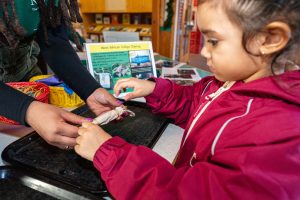
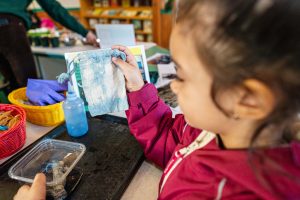

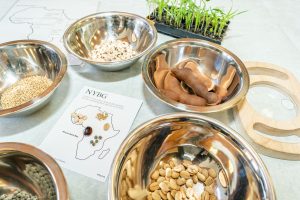

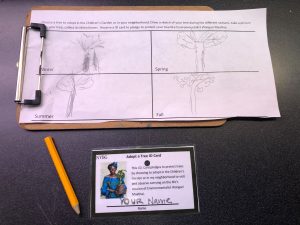
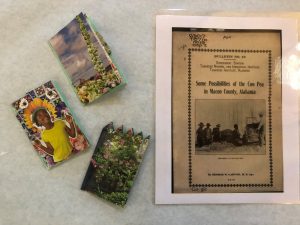
6 Responses to “Tale from the Field: Celebrating Black History, Rooted in Plants, at the New York Botanical Garden”
Wangari Maathi was the first African woman to be awarded the Nobel Peace Prize. However, She was the 7th African to be awarded the prize. https://africa.com/africas-nobel-peace-prize-laureates/
Thanks Cati, we fixed the content.
PS I should have started with saying that I love this post and the work that BEETLES does and shares so generously!
This is fantastic! Thank you Arvolyn Hill
Are there write ups to these activities? I would love to share these with folks?
Hey Regi,
Unfortunately not, though you can reach out to the New York Botanical Garden to see if they would be willing to share.
Leave a Response